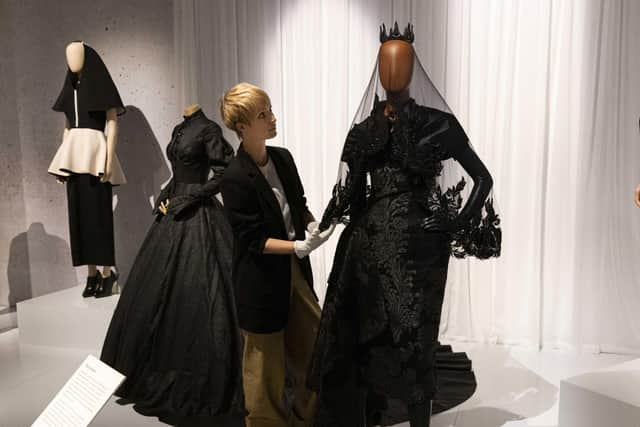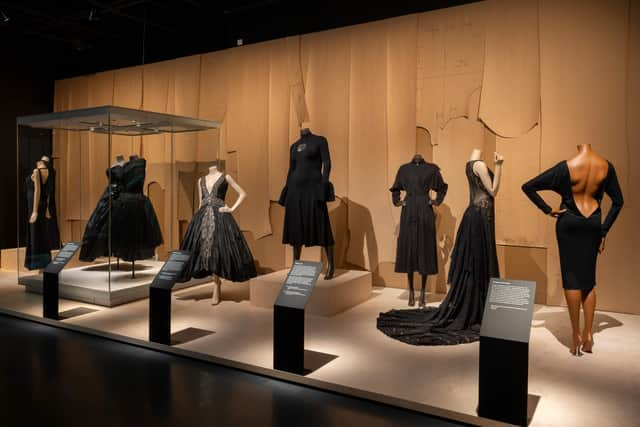Art reviews: Beyond the Little Black Dress | Rising Tide
Beyond the Little Black Dress, National Museum of Scotland, Edinburgh ****
Rising Tide: Art and Environment in Oceania, National Museum of Scotland, Edinburgh ****
Advertisement
Hide AdIn 1926, Coco Chanel launched the Little Black Dress. It was short and black, simple and unadorned. All the frou-frou and elaborate underpinnings of Edwardian women’s clothes were swept away and replaced by simplicity and ease of movement. Black was the colour of mourning and of the dresses of female servants, of maids and waitresses. An early piece of radical chic, Chanel called this appropriation “poverty de luxe” and the exhibition Beyond the Little Black Dress argues that it still echoes through the clothes of the succeeding century.


Black became a radical signal and haute couture appropriated, not only the clothes of the poor and the bereaved, but also the black gowns of priests and clerics. To then put those into an implicitly erotic context was certainly provocative, if not radical. At one point, too, we are told that black is the colour of revolution, but the French Revolution adopted the tricolore and the Russian Revolution was red. More pertinently, black was favoured by the Fascists – the Black Shirts – and the Nazis. SS uniforms were black. I doubt they owed much to Chanel, although her relations with the Nazis were questionable.
Punk’s adoption of black may also owe something to the Nazis (the use of Nazi symbols and references by Punk bands are well-documented), but though Punk features largely here that inconvenient fact is not touched on. Recently too, like Punk, the transgressive black imagery of S&M and fetish costumes has been adapted into high fashion. Versace staged a show called Miss S&M and there is a dress here by Franco Moschino with dramatic corset lacing up the back, though it is in shocking pink, not black. Punk, too, could be elegant. A dress from 1977 by Sandra Rhodes is carefully ripped and torn and adorned with silver chains and safety pins long before Liz Hurely’s notorious safety pin dress designed by Versace in 1994.
Expensive and exclusive, haute couture is, however, not really an obvious vehicle for radical ideas, and indeed one contemporary comment on Chanel’s Little Black dress was that it was the Model-T of costume. Henry Ford’s mass produced Model-T was the car for everyone. Chanel’s dress would be the same. It was, said Vogue, "the frock that all the world would wear,” but these clothes are certainly not for all the world, nor even very much of the female half of it. Nor was Chanel’s legacy unquestioned. If women’s clothes in the intervening 20 years broadly reflected her easy line and the industry was dominated by women like her, in 1947 Dior, representing a new breed of male couturier, challenged it directly with the New Look, clothes with voluptuous flowing lines achieved with corsets and pointy bras and, after the austerity of war, rejoicing in the shockingly extravagant use of materials.
Dior was still happy to use black, however, which slightly undermines the identity of black with radical chic. There is, for instance, a black cocktail dress he designed in 1951 and another for Wallis Simpson, the Duchess of Windsor, c.1949. Dior’s image of women endured through the fifties. A dress by Pierre Balmain from 1957 is an elegant mass of black frills, but things changed. I didn’t spot anything from the sixties, but around 1980, Yves Saint Laurent picked up again on Chanel’s line of thought with "le smoking.” Chanel admired the relative simplicity of men’s clothes and, in turn, Saint Laurent’s black suit with jacket and trousers was an elegant adaptation of the tuxedo for women.


The exhibition’s main focus is however on the contemporary semiotics of dress. Here it reflects two recent shifts. Haute couture depends financially on a very small number of very rich people. Art is largely the same, but its reach has hitherto been much greater than that limitation would suggest. The modern ubiquity of the image has changed that for haute couture, too, making its reach more like that of art. The red carpet has become an exhibition space. Likewise, the dress by Armani displayed here that was worn by the Duchess of Sussex for her television interview with Oprah Winfrey was seen by countless millions and its careful semiotics were no doubt parsed by many, as they are in the label here. There were strict rules for when royal women should wear black. She of course flouted them. The other shift is towards gender fluidity. Several examples here make it clear that you can no longer assume that these are clothes designed for one gender exclusively. Indeed, a rather baroque and not very black dress by Christian Seriano was worn for an awards ceremony by Jonathan Van Ness, star of Queer Eye, who identifies as non-binary, while Bill Porter wears a tuxedo gown, also by Christian Seriano.
Advertisement
Hide AdIf the argument here is patchy, the clothes are frequently stunning, perhaps especially some of the historic ones, a dress decorated with glass and sliver metal by an unknown designer from the late 1920s, for instance, or a simple and supremely elegant long dress by Elsa Schiaparelli from around 1939. But these historic costumes were meant to be worn. The shift in visibility means that is no longer necessary. It is the image that counts. In 2015, for instance, Gareth Pugh created a dress entirely from black plastic drinking straws. It bristles like a porcupine, is undoubtedly elegant and sexy, but is equally clearly impossible to wear. Since then the Me Too movement has inevitably impacted on an art form/industry whose concern has been exclusively the image of women and also too often as projected by men. Sinéad O’Dwyer works exclusively for sizes 18-22 and her Squiggle Suspender top and Naked Dress combination certainly looks both gender fluid and formidable. But the show ends futuristically with minimal clothes whose trick is to shimmer and flutter electronically, though not altogether in black.
Also in the Museum, Rising Tide: Art and Environment in Oceania is a very different kind of exhibition. The artworks and artefacts in it reflect on the perilous position of the inhabitants of the many Pacific Islands, threatened equally it seems here by rising sea levels and a rising tide of plastic waste. Defiantly however they declare, “We are not drowning. We are fighting.” They are adapting too. The traditional materials used in some art forms, such as coconut fibre or pandanus leaves, have been replaced in articles displayed here with plastic. But while much of this is informative, there are also two major pieces in the show. One by Yuki Kehara, made of barkcloth, shells, sequins, glass beads and plastic, consists of five kimonos which, hung together, form a terrifying tableau of a massive tsunami rising above sea, sky and islands to overwhelm them, although coconuts sprouting as they float in the water are put there as rather forlorn symbols of hope and possible regeneration.
Advertisement
Hide AdThe other major piece is by George Nuku. It is a room-sized installation of recycled plastic waste. The sea and all the creatures in it haven turned into plastic. The world is overwhelmed by it. The whole installation is however actually very beautiful and a raft carrying a roofed shelter floats precariously on the sea of transparent plastic. It is another symbol of hope, perhaps, but nothing in the show downplays the severity of the predicament of the people of these islands, where the crisis of climate change is more immediate and more urgent than anywhere else.
Beyond the Little Black Dress until 29 October; Rising Tide until 14 April